|
|
|
Jimmy Johnson Page
Posted
5/18/03
|
|
|
|
 |
|
|
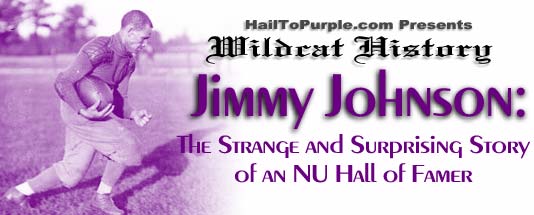

If
there is a Forest Gump of Northwestern Football, Jimmy Johnson is
almost
certainly he. Few, if any, other Wildcats had more brushes with,
and
connections to, landmark moments in the history of NU football-- in
fact,
the history of American Football in general. And yet, only a
handful
of 'Cat fans knows of his existence.
James E. Johnson's mother, Adis, was a full-blooded Stockbridge Indian.
The
Stockbridge
are
descendants of the Mohicans and continue to live on a reservation
northwest
of Green Bay, Wisconsin. The Stockbridge reservation existed when
Jimmy
Johnson was born, on June 6, 1879; however, the Johnson family lived
several hundred miles south, in Edgerton, Wisconsin.
As a child Johnson was
sent to the Carlisle Indian School in Carlisle, PA.
There he completed his secondary education and-- in the fall of
1899--
continued at Carlisle and began its college curriculum.
Coincidentally,
a new football coach was starting his tenure at Carlisle in 1899: Glen
"Pop"
Warner. By the time he left Carlisle, Pop Warner had transformed
the
Carlisle Indian football team into a national powerhouse and
international
story, and he had re-written the rules of American Football.
While preparing for his
first season at Carlisle, Warner selected
Johnson
for the Indian team, along with Frank Hudson. Hudson would become
famous
as one of the best quarterbacks and drop-kickers of his day.
Warner
certainly recognized the political climate of the time and the cultural
circumstances
of his athletes, who were all Native Americans and mostly from
reservations.
When preparing them for the season, he emphasized to his team the
opportunity
that the game of football afforded them: the chance to beat white men
on
their own field, at their own game.
|
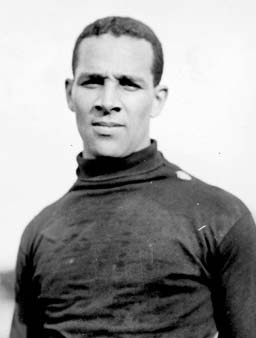
Johnson poses, wearing NU purple. Photo
courtesy of Chicago Hist. Soc.
|
All of Carlisle's games were played on the road: the team became a
traveling
show of sorts. Warner's scarlet and
gold-clad players were a journalist sensation, with heavy newspaper
coverage everywhere. The team began
playing over fourteen games a season,
touring campuses all over the country, taking on the biggest teams of
the
day.
By the end of autumn, 1899, Johnson and the rest of the Indian team had
played throughout
the nation. The Indian Helper, a weekly newsletter
published by Carlisle,
included the following passage concerning Johnson in its December 22,
1899
edition:
"A letter from James Johnson of
the
football team to his teacher, Miss Wood, tells of his having passed Des
Moines,
Iowa, and all were well. They are expecting a happy time.
They
met Dr. Carlos Montezuma, Chicago's Apache physician, who is with them
on
their journey. Johnson saw his sisters in Chicago."
Over the course of the next two seasons Johnson became Pop Warner's
star,
succeeding Hudson at quarterback and assuming the team's Captain
position.
During the 1903 season Johnson led Carlisle to even greater
national
prominence, culminating in a game against Harvard, the dominant power
of
the day.
While the Carlisle-Harvard game was a close fought, spectacular game,
it would become the stuff of legend because of one single play, a
moment
that is among the most famous in sports. Prior to the game, Pop
Warner
sewed an elastic strap inside the jersey of Charles Dillon.
When Harvard
kicked off to start the second half, Jimmy Johnson caught the ball.
Rather than block for Johnson, the
team immediately huddled around him, as he took the ball and stuffed it
inside the back of Dillon's rigged jersey, just above the elastic.
The team
then broke the huddle, with all eleven players clutching their chests
and
running madly. The Harvard players, bewildered, allowed Dillon to
run
over 80 yards untouched for a touchdown. Although Harvard won the
game
by one point, Carlisle's trick play, and Jimmy Johnson's quick work
with
the ball, caused a sensation. The play has since been reproduced
everywhere, even in the movie M*A*S*H.
Word of the "Hidden Ball" play spread across the country, as did the
news
of Carlisle's nine-win season. Another successful team causing a
furor
at this time was Northwestern. By late November NU had won ten
games
and was in a controversial tie for the Western Championship.
Before
the season, no one had expected the Purple even to be good; now the
media
were abuzz with NU, and the team's games were getting national
attention
for the first time ever. The NU - Chicago game, a 0-0 tie, was
one
of the biggest games of the year. In fact, Northwestern football
was
getting so much attention in 1903 that the team decided to move their
last three
home games away from small Sheppard Field (NU's home campus
field) to the White Sox playing grounds at 39th Street, in order to
accommodate
the enormous crowds. NU concluded its '03 title season on
Thanksgiving
Day by taking on Jimmy Johnson and Carlisle at Sox Park.
Even though NU had little to gain or lose from the game-- it would not
factor
in conference standings, after all-- the match was billed as the
biggest
game in the country, eclipsing even Thanksgiving games being held in
the
East. Prior to the game, NU's excellent coach, Wally McCornack,
commented
on the match and on the trick plays Carlisle had unleashed on Harvard:
"If
the Indians can work tricks, so can the White Man!" Indeed, NU
could:
the Purple at the time had a playbook with 128 plays, a ridiculous
amount
of plays for that era.
The NU - Carlisle match, unfortunately, was no contest. NU had
been
riddled with injuries and severely weakened by the hard-fought tie with
Chicago
and an equally grueling tie with Notre Dame. Johnson and Carlisle
were at the top of their form. In a driving blizzard at Sox Park,
in
front of 11,000 Purple fans, Jimmy Johnson played his last game for Pop
Warner
and almost single-handedly beat Northwestern 28-0. Johnson
actually
missed four drop kicks during the game, but made up for them with a
series
of dazzling runs. The Tribune reporter at the game marveled,
"Captain
Johnson is always a wonder!" After the game, Johnson said, "I am
glad
we won, as we came a long distance to do it, and I consider that we did
pretty
well. Northwestern was not as hard a proposition as I expected.
We
would have made a larger score if the field had not been so slippery."
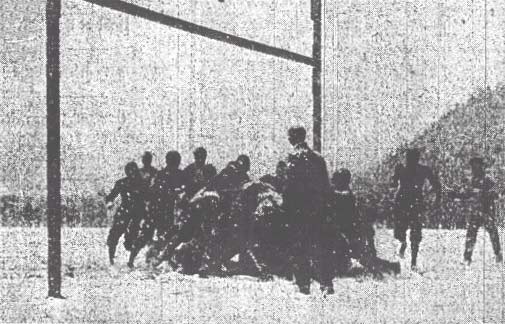 Carlisle and NU battle in the snow at Sox Park.
Photo processed from
Carlisle and NU battle in the snow at Sox Park.
Photo processed from
an image originally in the Chicago Tribune.
And
so both NU and Carlisle ended the 1903 season with ten wins apiece.
Johnson
earned a place on Walter Camp's All America roster, and then went on to
make
another strange piece of NU history by being the only player ever to
play
against the Purple in a game, only to play for NU in his
very
next football game. After graduating from Carlisle in 1904,
Johnson
enrolled in NU's Dental School. Although the Dental School still
had
a football team of its own, Johnson's renown and skill were too good
for
the Varsity team to pass up (until 1906, it was perfectly legal for a
school
to use graduate students, even if the student had played four years
somewhere
else).
Johnson quickly became captain of the NU squad (an honor he shared with
Harry
Allen; eventually only Allen's name would be left on the captain
roster)
and began helping McCornack prepare his team. The Tribune
reported
just prior to the start of the season, "The most pleasing thing to the
NU
rooters was the appearance [at practice] of the two Carlisle Indians,
Johnson,
who was placed on Walter Camp's All America team, and Williams. . . .
Johnson
demonstrated that he is all that has been claimed. The way he
handled
punts on the dead run was most impressive."
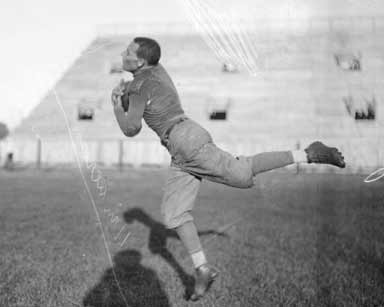 Photo courtesy of Chicago Hist. Soc.
Photo courtesy of Chicago Hist. Soc.
During the next two seasons, NU played 21 games and won 16, tying one.
Of
the four games NU lost, Johnson did not play in two, due to injuries.
At
the end of 1904 Johnson scored the winning touchdown against Illinois
at
Sheppard Field, the last score ever to be made on that field. He
also
was there to inaugurate the new Northwestern Field in 1905, rampaging
through
four preseason wins on the field before the dedication game with
Beloit.
During the Beloit game Johnson tore through for 200 yards, a
tremendous
amount for the time. Johnson's performance was a relief to
McCornack,
since Jimmy had missed the team training for the 1905 season, on a
wedding
tour.
Johnson continued to score at will during 1905, leading NU to wins
against
Marquette, Ohio Northern and Michigan State. Even with the
winning
record, NU was woefully short of depth and Johnson, now 26 years old,
had
been banged up terribly over the last two years. The Purple were
heavy
underdogs for their final game of the year (and their only road game),
against
national powerhouse Minnesota. Sadly, Johnson went down with a
career-ending
injury just ten minutes into the game, and NU was doomed without its
star
quarterback. When Johnson and NU left the field that day, he took
his
place on yet another footnote in NU history: the NU-Minnesota game was
the
last NU was to play for three years. In the spring of 1906 NU's
faculty
voted to terminate the varsity team, ending 24 years of NU football.
Having played in his team's final game, with his football career over
and
having earned his dental degree from Northwestern, Jimmy Johnson and
his
family left Evanston. He fought in World War I, eventually
settled in San Juan, Puerto
Rico
and practiced dentistry there. Johnson died at the Mayo Clinic in
Minnesota in January 1942. He is buried in Chicago.
Many thanks to the College Football
Hall of Fame and to Clarence Cameron for their assistance in the
research for
this article.
|
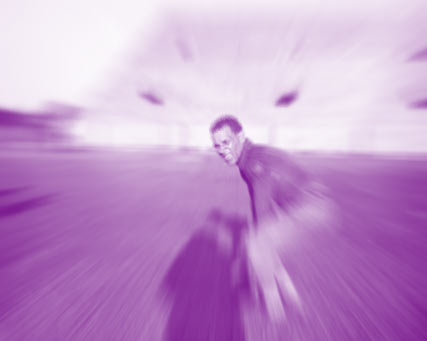 All-American, member of the College Football Hall of
Fame,
All-American, member of the College Football Hall of
Fame,
a footnote on many pages of football history.

|
|
|
